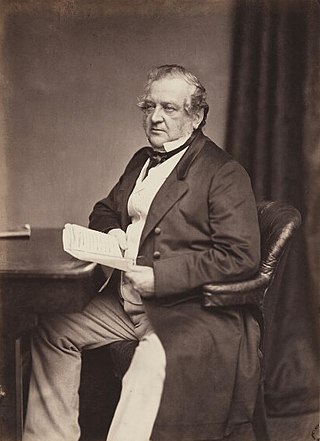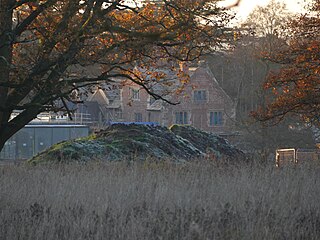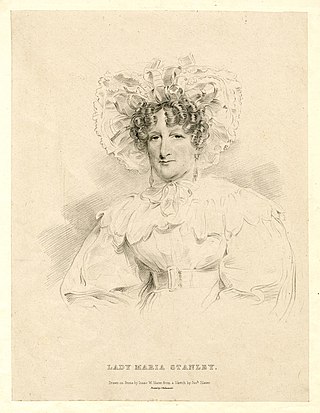
Baron Stanley of Alderley, in the County of Chester, is a title in the Peerage of the United Kingdom. It was created in 1839 for the politician and landowner Sir John Stanley, 7th Baronet. Upon his death in 1850, he was succeeded as 2nd Baron Stanley of Alderley and 8th Baronet of Alderley Hall by his son Edward, who was a prominent Liberal politician and notably served as President of the Board of Trade, Postmaster General and had in 1848 been created Baron Eddisbury, of Winnington in the County Palatine of Chester, in his own right. His wife Henrietta was a prominent campaigner for women's education. After his death, the Stanley of Alderley and Eddisbury baronies remained united; most holders have since chosen to be known as Lord Stanley of Alderley. The 3rd Baron Stanley of Alderley had a career in the Diplomatic Service; as he was childless he was succeeded by his younger brother, the 4th Baron. He was liberal member of parliament for Oldham. In 1909, the 4th Baron Stanley of Alderley acquired a further title when he succeeded his first cousin once removed, the Earl of Sheffield, according to a special remainder and thus inherited the title of 4th Baron Sheffield. After his death the titles passed to his son, the 5th Baron Stanley of Alderley. He was Liberal Member of Parliament for Eddisbury and also served as Governor of Victoria. His eldest son, the 6th Baron Stanley of Alderley, sold the family seat of Alderley Hall in 1938. He was married four times, the second time to Sylvia Ashley. On his death the titles passed to his younger brother, who preferred to be known as Lord Sheffield. He only held the titles for three months. As of 2013 the titles are held by the latter's cousin, the 9th Baron Stanley of Alderley, who succeeded his father in that year. He is the grandson of Oliver Hugh Stanley, youngest son of the 4th Baron.

Alderley Edge is a village and civil parish in Cheshire, England. In 2011, it had a population of 4,780.

Edward John Stanley, 2nd Baron Stanley of Alderley,, known as The Lord Eddisbury between 1848 and 1850, was a British politician.

Dunham Massey is a civil parish in the Metropolitan Borough of Trafford, Greater Manchester, England. The parish includes the villages of Sinderland Green, Dunham Woodhouses and Dunham Town, along with Dunham Massey Hall and Park, formerly the home of the last Earl of Stamford and owned by the National Trust since 1976. Dunham Massey is in the historic county of Cheshire, but since 1974 has been part of Trafford Metropolitan Borough; the nearest town is Altrincham. At the 2001 census, the parish had a population of 475.

Great Warford is a village and civil parish in the unitary authority of Cheshire East and the ceremonial county of Cheshire, England.
Quantock Lodge is a grade II listed nineteenth-century Gothic revival mansion built by Henry Labouchere, 1st Baron Taunton (1798–1869), to the design of Henry Clutton. It is built from Cockercombe tuff and is located near Aley in the parish of Over Stowey in Somerset. It has variously been used as an estate, a sanatorium and a school.

John Thomas Stanley, 1st Baron Stanley of Alderley, known as Sir John Stanley, 7th Baronet, from 1807 to 1839, was a British peer and politician.
Henry Edward John Stanley, 3rd Baron Stanley of Alderley and 2nd Baron Eddisbury or Abdul Rahman Stanley,, was a British historian who translated The first voyage round the world by Magellan and other works from the Age of Discovery. A convert to Islam, in 1869 Lord Stanley became the first Muslim member of the House of Lords.

Cheshire East is a unitary authority area with borough status in the ceremonial county of Cheshire, England. The local authority is Cheshire East Council. Towns within the area include Crewe, Macclesfield, Congleton, Sandbach, Wilmslow, Handforth, Knutsford, Poynton, Bollington, Alsager and Nantwich. The council is based in the town of Sandbach.

St Mary's Church is an Anglican church at the end of a lane to the south of the village of Nether Alderley, Cheshire, England. It dates from the 14th century, with later additions and a major restoration in the late-19th century. The church is recorded in the National Heritage List for England as a designated Grade I listed building.
Winnington Hall is a former country house in Winnington, now a suburb of Northwich, Cheshire, England. It is recorded in the National Heritage List for England as a designated Grade I listed building. The building is in effect two houses joined, an older modest timber-framed house, and a newer, more elegant, stone house.

Nether Alderley is a village and civil parish in Cheshire, England, on the A34 a mile and a half south of Alderley Edge. The civil parish includes the hamlets of Monk's Heath and Soss Moss.

Hon. William Owen Stanley was a British Liberal Party politician.

Alderley Old Hall is the remaining part of a former 17th-century manor house near the village of Nether Alderley, Cheshire, England. It stands adjacent to the mill pond of Nether Alderley Mill, a loop of which acts as a moat. The hall is recorded in the National Heritage List for England as a designated Grade II* listed building.
Alderley Edge is a civil parish in Cheshire East, England. It contains 30 buildings that are recorded in the National Heritage List for England as designated listed buildings. Of these, one is listed at Grade I, the highest grade, one is listed at Grade II*, the middle grade, and the others are at Grade II. The parish contains the village of Alderley Edge, which became a dormitory settlement for workers in Manchester following the arrival of the railway in 1842. Included in the listed buildings are mansions for the more wealthy businessmen. In the countryside surrounding the village are listed houses, cottages, and farm buildings. Within the village, in addition to houses, the listed buildings include a former railway hotel, churches, a school, a bank, a drinking fountain, a war memorial, and a garage.
Nether Alderley is a civil parish in Cheshire East, England. It contains 56 buildings that are recorded in the National Heritage List for England as designated listed buildings. Of these, one is listed at Grade I, the highest grade, four are listed at Grade II*, the middle grade, and the others are at Grade II. The parish contains the village of Nether Alderley. The largest house in the parish was the Old Hall which was damaged by fire in 1779. This was replaced on a different site by Park House in Alderley Park. This was in turn damaged by fire in 1931, and was demolished in 1933. Much of the park has since been used by a major pharmaceutical company.

The New Frontiers Science Park is a science park in Essex, on a redeveloped research site of GlaxoSmithKline (GSK).

Maria Stanley, Baroness Stanley of Alderley was a British letter writer and liberal advocate.















